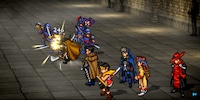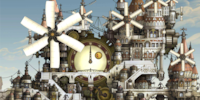
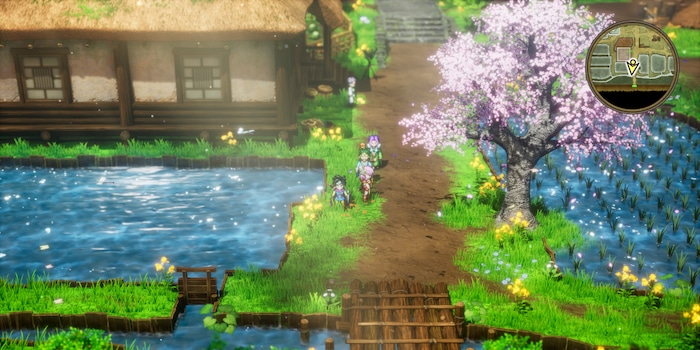
Dragon Quest III HD-2D Remake: a successful rerelease of a classic
The HD-2D style has never been as beautiful as in Dragon Quest III HD-2D Remake. The remake is impressive, both in terms of its visual appearance as well as its great general implementation.
Remakes of classics are all the rage. For developers, however, they’re usually a balancing act. If they change too little, they don’t do justice to the original. If they change too much, the games no longer feel like the original.
Luckily, I can give the all-clear for Dragon Quest III HD-2D Remake. Publisher Square Enix and the various development teams tasked with the remake have conquered this balancing act. The game delights me with its modern visuals and enchants me with the magic of old JRPGs.
Beautiful HD-2D style
The most obvious change is the graphics. As with so many remakes of classic JRPGs, it’s based on the Octopath Traveler art style. However, in contrast to this, backgrounds are much clearer. The developers changed this following feedback from series creator Yuji Horii (article in German). I really prefer this over the blatant blurring in Octopath Traveler.
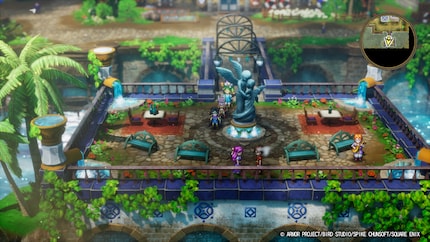
Source: Kevin Hofer
The colours are much stronger than in the original, but they still capture the spirit of the 1988 version well. The highlight for me is the tracking shots that are played every time I enter a new location. The world simply looks beautiful. Small details, such as birds flying by or trees bending in the wind, also contribute to this.
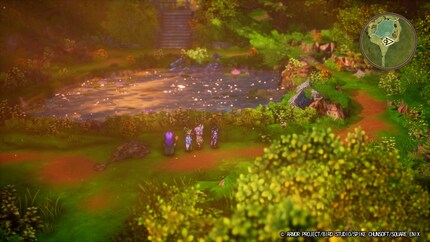
Source: Kevin Hofer
The graphics during battles also look great. As in the original, you fight from a kind of first-person perspective, but the refreshed models and animations make me forget that I can’t see my characters.
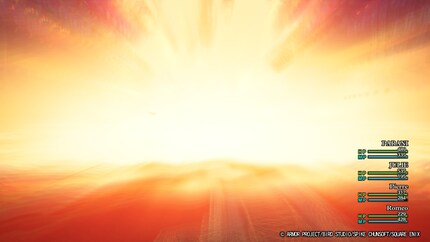
Source: Kevin Hofer
Bland characters
Dragon Quest III dates all the way back to 1988. A time when the prevalent traits of heroes weren’t yet as developed as they are today. Or not at all, as in the case of this title. To start, I choose the name and appearance of my character. I opt for a heroine, dubbing her Parani.
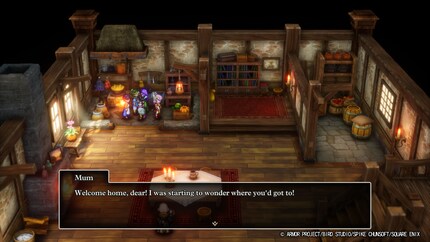
Source: Kevin Hofer
Right off the bat, Parani has to undergo a personality test. However, it has no influence on the story, only on the development of my attributes. So despite the test, my protagonist has the personality of a stick. Everything I learn about her, I learn from third parties. Neither she nor her three party members speak during the game. I have to interpret every emotion. As a result, relating to Parani is pretty difficult. The narrative focus lies squarely on the story.
Parani is the daughter of Ortega, a well-known hero who went missing while trying to defeat his arch-enemy Baramos. And guess what? He’s back to threaten the world once again. And so, on her sixteenth birthday, my heroine has to set out to rescue it. She’s ordered to do so by the King of Aliahan, who gives her a few medicinal herbs and 50 gold for her journey.
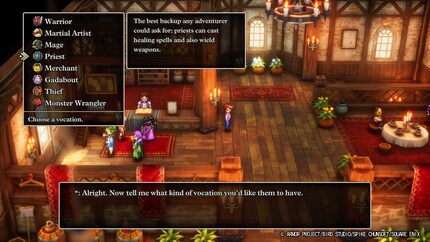
Source: Kevin Hofer
But before that happens, I can pick up three party members. I can choose their class, gender and appearance too, just as with Parani. I decide to go for a balanced party: hero, mage, priest and fighter.
«Wait, where are we going?» Just talk to people
OK, to be precise, I should ask, «Where exactly are we going?». I don’t know at first, and set off without a clue. Like the original, Dragon Quest III HD-2D Remake follows a hands-off approach when it comes to gameplay. Neither the combat system nor the continuing story is explained to me. I learn all of this in passing by talking to numerous NPCs, who all share the same four or five character models.
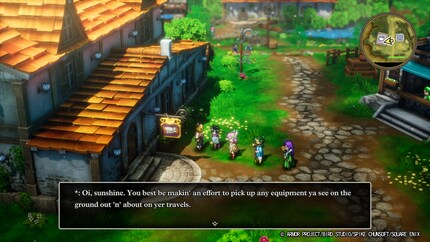
Source: Kevin Hofer
Well, almost: I can optionally activate quest markers in the remake, which indicate my next goal on the map. Or I can make use of the recall function. With it, I can save the last lines of an NPC’s dialogue and call them up again at any time so I know where to go.
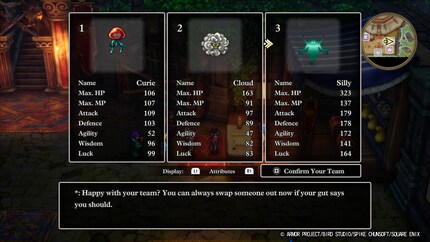
Source: Kevin Hofer
In short, you should be able to get where you’re going. And not a second too late, as the game suddenly veers into Pokémon territory in the next big city’s monster arena. Here, I can pit friendly monsters scattered all over the world against others. Unlike the original, however, I control the monsters like my heroine and her gang. The arenas are optional, but money and items are up for grabs.
Most quality of life features can be found in the combat system
The combat in Dragon Quest III HD-2D Remake is turn-based, just like in the original. In other words, I give orders to my four characters – or up to three monsters in the arena. They then execute these in the order of their agility values. Nothing new there.

Source: Kevin Hofer
In the remake, I can also let the computer fight for me. To do so, I choose the behaviour of individual characters or the whole group. They can give it their all, fight smart, focus on healing or play defensively. Due to the many random encounters with monsters, automated combat is a welcome quality of life feature.
Unfortunately, random encounters can neither be reduced nor switched off completely. In return, I can influence the speed of battles. This is another welcome feature, since I have to level up my party before our first major boss. This is massively simplified by the higher combat speed.
After each battle, my characters receive experience points and can level up. In addition to improved status points, there are also new abilities. I can’t choose these. They’re determined by class and level, so a balanced party is important. Both a mage for magic attacks and a priest for healing are near-obligatory. As a result, I can only freely choose my last class. Still, the combat system offers enough depth to prevent boredom. But it is and remains a 36-year-old system.
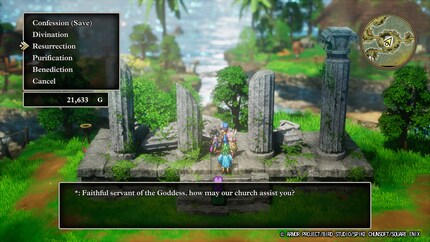
Source: Kevin Hofer
As in the original, I can only revive my characters in the church at the start. Later, my heroine and priest do learn similar spells, but whether these revives are successful or not is left to chance. Sometimes, I had to use the spell four or five times. From today’s perspective, this isn’t only unnecessary, but annoying too. I’d have liked to see a change here, especially since the developers included a quality of life feature for healing – I can hold down the triangle button in the menu on PlayStation to fully heal all party members.

Source: Kevin Hofer
The magic of old JRPGs
Dragon Quest III HD-2D Remake invites you to explore. I find armour or other items in pots, and there are small, unmarked areas on the map. NPCs even tell me about hidden treasures or remote locations that I could visit. Even though the remake has a modern look, the magic of the early JRPGs remains. After all, there’s a reason why Dragon Quest is considered the blueprint for the genre.
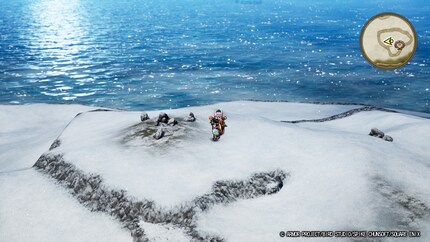
Source: Kevin Hofer
When I visit a new area, a self-contained story is always told. For example, a tale of two tragic lovers à la Romeo and Juliet. Or that of a once-loving king who has degenerated into a corrupt tyrant. From today’s perspective, where everything always has to have some kind of connection and characters always reappear, this seems old-fashioned. I’d also find this strict separation weird in a new game. But that’s how stories were told back then.
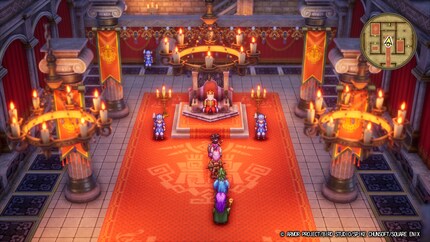
Source: Kevin Hofer
Although the remake offers new story content, it doesn’t change the original. Its few new passages complement the story in a meaningful way – sometimes even with new boss fights. I have to make up a lot of things in Dragon Quest III HD-2D Remake – that, or the story’s left to my imagination. The developers have found an excellent balance here.
Even if my heroine remains underdeveloped and the story is black and white, Dragon Quest III HD-2D Remake captivates me for 27 hours. This isn’t least down to the soundtrack. It’s simply fantastic, perfectly underscoring the visually enhanced world of Dragon Quest. The developers also combine the orchestral arrangement with classic sound effects, giving the game its own charm.
Dragon Quest III HD-2D Remake will be released on 14 November 2024 for PC, Nintendo Switch, PlayStation 5, and Xbox Series. The PlayStation 5 version was provided to me by Square Enix for testing purposes.
In a nutshell
A remake that strikes an almost perfect balance between old and new
Dragon Quest III HD-2D Remake does justice to the original in all respects. The wonderful classic gets even better thanks to this remake.
It all starts with the simply brilliant visual and acoustic design. The HD-2D style has never looked this good. It continues with the many quality of life features across the menus and combat system. The few story expansions make sense and don’t distort the spirit of the original.
I can only criticise a few details. At 36 years old, the story – and above all its narrative style – seems old-fashioned. Characters remain pretty flat until the end, but that was already the case with the original and is part of the retro charm. As far as the quality of life features are concerned, I’d have particularly liked the option of switching off random battles completely.
Pro
- Expands the original in a meaningful way without ruining it
- Great presentation
- Invites you to explore
Contra
- Old-fashioned story and narrative style
- Random battles can’t be turned off

From big data to big brother, Cyborgs to Sci-Fi. All aspects of technology and society fascinate me.
Which films, shows, books, games or board games are genuinely great? Recommendations from our personal experience.
Show all